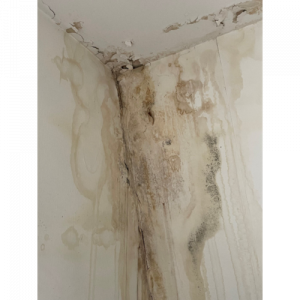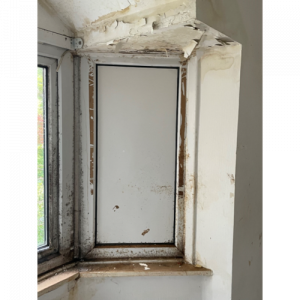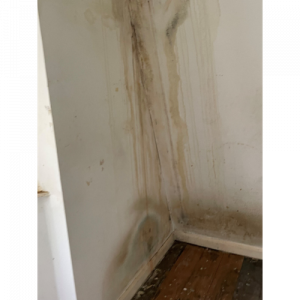Damp in properties is a serious issue when it occurs. From health issues to structural damage, an excess of moisture can have significant effects on individuals and business owners.
Many of the materials we use in construction contain moisture which dry out both during and after the construction process. However, if these are not allowed to dry out properly, or additional excess moisture is introduced which does not have a way to escape, this can result in damp.
While it is easy to say that damp is caused by excess moisture, there are many aspects that can cause or contribute to the build-up of moisture. Here are just a few examples:
- Plumbing or drainage issues, both internal and external to the property
- Blocked gutters or
- A leaking roof
- A breached or faulty damp proof course
- Missing or inadequate damp proof course
- Poor workmanship
- Poor ventilation
There are too many possible causes of damp to go into in this short blog. Instead, we want to devote some time in this article to outlining some of the possible dangers which not addressing damp could lead to, as well as the different types of damp that exist and the difficulties of dealing with them.
If you believe that your property may be affected by damp, please do contact a member of our Building Surveying team for some expert advice.
The dangers of damp
Damp in properties will invariably lead to the growth of mould in various forms. Most of us know that mould in a property can be harmful to our health. Not only can the spores aggravate existing respiratory problems, but the allergens produced by moulds can cause other allergic reactions, such as sneezing, a runny nose, red eyes or skin rashes.
In extreme cases, these allergens can lead to respiratory infections or asthma attacks and have also been known to impact the immune system, making those exposed to the mould more vulnerable to other infections or diseases.
Research published in February 2023 has also shown that damp conditions can also affect the mental health of those exposed to them, with both depression and anxiety being more prevalent in those people living in damp conditions.
But it is not just the effect on health that is a danger if damp is left unchecked. Mould and damp conditions result in rotting timbers and damage to plastering and masonry. If these are not addressed, the structural integrity of the property can be affected, leading to an increased risk of damage.
The difficulties of damp
Ultimately, damp is always caused by an excess of moisture within the property, but where this moisture comes from is not always clear. Determining the cause of damp is one of the first steps to taking corrective action. Without knowing what is causing it, time and money could be spent in unnecessary and ineffective remedial work.
The types of damp
When we are investigating the cause of damp, there are four primary types of damp we are looking for: condensation, interstitial condensation, rising damp and penetrating damp.
Condensation
Condensation is probably the most common cause of damp in residential properties in the UK, but also affects commercial properties.
Condensation is caused when warm air comes into contact with a cooler surface, such as walls or windows, resulting in the formation of water droplets. If this excess moisture is not removed, it can lead to mould and mildew. Condensation is particularly prevalent in rooms with a high level of moisture, such as shower and bathrooms, kitchens, and laundry rooms.
However, despite being so common, condensation is also relatively easy to tackle. If you see condensation building, ensuring that the moisture is removed will stop the mould from forming. You can do this by drying the affected area and then looking for ways to improve ventilation within the room, giving the moisture a way out. Trickle vents in double glazing, the addition of extractor fans to kitchens or bathrooms, or the use of dehumidifiers in rooms where the problem occurs most readily are all relatively cost-effective ways to reduce levels of condensation in the short term.
If condensation is an ongoing problem, discussing it with a Surveyor may provide other long-term solutions which will allow the air to circulate, ensuring your property can “breath” and allow moisture to escape.
Interstitial condensation
A more serious form of condensation is interstitial condensation. This type of condensation occurs when moist air gets trapped inside an enclosed wall, roof, or floor cavity. As the warm, moist air reacts with the cooler surfaces, it condenses into water droplets, which can pool and cause damp. The warm air can come from within the property or from external sources, especially on warm days.
Interstitial condensation is more dangerous to properties as it often occurs in areas that are not visible. As it continues, the damp and mould created can damage the structure of the property, often quite seriously, before the existence of the damp becomes obvious.
Rising damp
Rising damp occurs when moisture rises from the ground through a wall or floor. This is a natural occurrence that is usually stopped by a damp-proof course or membrane. Because the moisture that causes this kind of damp comes from the ground, it only occurs on the ground floor of buildings and is most easily recognised by “tidemarks” appearing on the walls. These tidemarks appear once gravity or evaporation have stopped the moisture rising any higher up the wall, normally at about 1m above floor level.
Older properties that do not have a damp-proof course are more likely to experience cases of rising damp than more modern properties. However, if the damp-proof course has been damaged in some way modern properties will also see this kind of damp appearing.
In addition, changes made to the ground outside the property, for example through raised garden beds of the addition of a new drive, could also affect effectiveness of the damp-roof course, or even block ventilation bricks, increasing the risk of rising damp.
Penetrating damp
Penetrating damp is caused when moisture seeps into the property through ceilings, floors and walls, and is normally related to structural issues. There are numerous causes of penetrating damp, but some examples include things such as damaged roofing tiles or felt, faulty guttering, burst pipes and other plumbing issues, and cracks in walls or brickwork.
Penetrating damp will often make itself visible through damage to plastering, decaying timber or watermarks on masonry. However, as with interstitial condensation, the existence of penetrating damp may not always be immediately visible, especially if it is occurring in areas that are not accessed or inspected on a regular basis.
Finding the cause
As you will see from the above, identifying the cause of damp within a property will depend greatly on which type of damp is occurring. In some instances, the likely cause will be easier to identify and resolve, while others, such as penetrating damp or interstitial condensation, are more complex, often requiring more comprehensive investigation.
Consider an example of penetrating damp caused by a leak in a roof. Water entering the property from a damaged roof will seek the path of least resistance as it trickles into attic or roof spaces, often traveling along beams or insulation material. This can cause damp patches on ceilings to appear far from the source of the leak. Restricted access or areas covered by insulation material can make finding the source even more difficult.
Buildings that have been retrofitted to improve their energy efficiency without taking into account that the building needs to “breath” can increase the risk of damp, especially condensation. With increased requirements to make buildings more energy efficient, ensuring this is done in a way that does not increase the risk of damp and mould developing in the buildings is becoming ever more important.
Here are some examples of what damp may look like.
How AWH can help
While the existence of damp may become visible to the naked eye quite quickly, understanding the cause and how best to treat it may not be as easy. While condensation may be reduced through opening windows, understanding what is contributing to the build-up of moisture in the first place could help with putting effective, long-term solutions in place.
If you have found signs of damp in your home or commercial property, please do not delay in speaking to a member of our team of experienced Building Surveyors. Understanding what is causing the damp and putting solutions in place early can save you money in the long run, as well as protect your health.
If you are planning to make changes to your property, either through development or retrofitting it for greater energy efficiency, our Building Surveyors can offer invaluable, expert advice. Their knowledge of building materials, regulations, and airflow requirements could prove invaluable in reducing the risk of damp. Speak to our Building Surveying team on 0800 071 5517 or email amdin@awh.co.uk.







